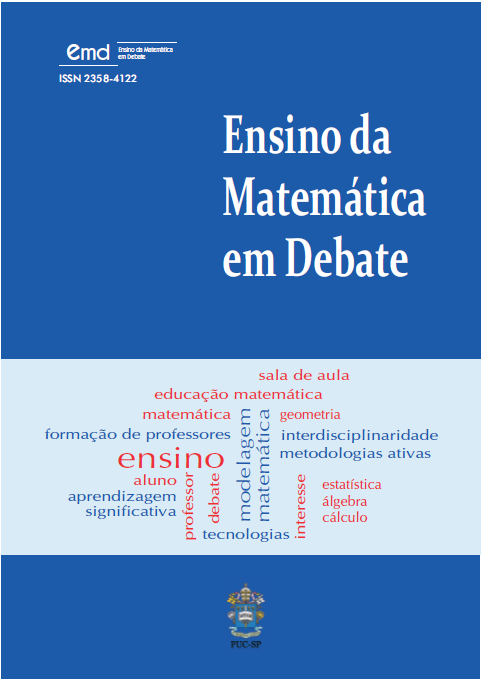Possibilities Study of Virtual Learning Objects Using in Conics Teaching through an Pedagogical Imagination Exercise
Keywords:
Ellipse, Parabola, Hyperbola, GeoGebra, High SchoolAbstract
This article has as objective to present a possibility study for the use of virtual learning objects (OVA), developed in GeoGebra, aiming conics teaching in High School. The work is characterized as a qualitative propositional research in which possibility and potential analysis of interaction and Mathematics concepts approach was carried out from ten OVA, through a pedagogical imagination exercise, developed by the authors, from Skovsmose's perspective. In this exercise, concepts, elements and properties of the ellipse, the parabola and the hyperbola were listed, which can be explored; in particular the reflective property which can be used in different applications. It is also noteworthy the possibility of manipulating the OVA elements resulting a better viewing and understanding of mathematical results by the students present in these objects. It is expected that the didactic material produced will be used by High School teachers in Mathematics classes.
References
ALCÂNTARA, R. L. Utilização dos OVAs (Objetos Virtuais de Aprendizagem) no processo de aprendizagem de alunos desde as séries iniciais utilizando Power Point. Revista Eletrônica Argentina-Brasil de Tecnologias da Informação e da Comunicação, v. 1, n. 3, 2015. Disponível em: https://revistas.setrem.com.br/index.php/reabtic/article/view/79. Acesso em: 08 dez. 2021.
AUDINO, D. F; NASCIMENTO, R. S. Objetos de aprendizagem – diálogos entre conceitos: uma nova proposição aplicada à educação. Revista Contemporânea de Educação, v. 5, n. 10, p. 128-148, 2010. Disponível em https://revistas.ufrj.br/index.php/rce/article/view/1620/1468. Acesso em: 08. nov. 2021
BICUDO, M. A. V. Pesquisa qualitativa e pesquisa qualitativa segundo a abordagem fenomenológica. In: BORBA, M. C.; ARAÚJO, J. L. (Org.). Pesquisa Qualitativa em Educação Matemática. São Paulo: Autêntica, 2019, p. 107-119.
BOGDAN, R.; BIKLEN, S. Investigação qualitativa em educação: uma introdução à teoria e aos métodos. Portugal: Porto Editora, 1997.
BORBA, M. C.; SCUCUGLIA, R. S.; GADANIDIS, G. Fases das Tecnologias Digitais em Educação Matemática: sala de aula e Internet em movimento. Belo Horizonte: Autêntica, 2015.
BRASIL. Parâmetros Curriculares Nacionais. Orientações didáticas. Brasília: MEC/SEF, 1998.
BRASIL. Ministério da Educação. Base Nacional Comum Curricular. Brasília: MEC/UNDIME, 2018.
FIORENTINI, D.; LORENZATO, S. Investigação em educação matemática: percursos teóricos e metodológicos. 3. ed. rev. Campinas: Autores Associados, 2012.
GUARDA, S. M.; PETRY, V. J. Uso de Objetos Virtuais de Aprendizagem Visando a Compreensão e a Representação de Elementos da Geometria Analítica. Acta Latinoamericana de Matemática Educativa, v. 33, n. 1, p. 707-7017, 2020.
HAY, R. H.; KNAACK, L. Evaluating the learning in learning objects. Open Learning: The Journal of Open and Distance Education, v. 22, n. 1, p. 5-28, 2007.
KENSKI, V. M. Aprendizagem Mediada pela Tecnologia. Revista Diálogo Educacional, v. 4, n. 10, p. 47-56, 2003.
LIMA, P. C. Imaginação pedagógica, educação matemática e inclusão: em busca de possibilidades para as aulas de Matemática. Intermaths. v. 2, n. 1, p. 121-137, 2021. Disponível em: https://periodicos2.uesb.br/index.php/intermaths/article/download/8595/5927. Acesso em: 19 set. 2021.
OLIVEIRA, C.; MOURA, S. P.; SOUSA, E. R. TIC’S na educação: a utilização das tecnologias da informação e comunicação na aprendizagem do aluno. Pedagogia em Ação, v. 7, n. 1, p. 1-21, 2015.
PONTE, J. P. Investigação sobre investigações matemáticas em Portugal. Investigar em Educação, v. 2, p. 93-169, 2003.
SCHEFFER, N. F. A argumentação em matemática na interação com tecnologias. Ciência e Natura, v. 34, p. 23-38, 2012.
SKOVSMOSE, O. Pesquisando o que não é, mas poderia ser. In: D’AMBROSIO, U.; LOPES, C. E. (Org.). Vertentes da subversão na produção científica em educação matemática. Campinas: Mercado de Letras, 2015, p. 63-90.
SPINELLI, W. Os Objetos Virtuais de Aprendizagem: ação, criação e conhecimento. s/d. Disponível em: http://www.lapef.fe.usp.br/rived/textoscomplementares/textoImodulo5.pdf. Acesso em: 28 jul. 2021.
Downloads
Published
How to Cite
Issue
Section
License
Copyright (c) 2022 Ensino da Matemática em Debate

This work is licensed under a Creative Commons Attribution-NonCommercial 4.0 International License.

Este obra está licenciado com uma Licença Creative Commons Atribuição 4.0 Internacional.





